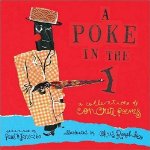Paul B. Janeczko
Illustrated by Chris Raschka
Poetry Picture Book
For ages 6 to 9
Candlewick Press, 2005, 978-0-7636-2376-0
For most of us a poem is a form of writing where words
are presented to the reader in creative ways to conjure up images, thoughts,
and feelings. How the words look on the page is not really that important.
Concrete poems are still a form of poetry, but their appearance matters a great
deal. They are “visually arresting” because the poet has tried to create a
visual effect with his or her words in addition to an intellectual and
emotional effect.
For this
splendid collection of concrete poems, Paul Janeczko has chosen poems that are
presented in unique pictorial ways. For example in Skipping Rope Spell by John Agard, the lines of the poem are not
presented in well behaved rows that stretch from left to right. Instead, they
swirl across the pages, twirling the way skipping ropes do when they are circling
through the air.
In Sylvia
Cassedy’s poem Queue the words stand
in a neat line down the page, one word under the other, just the way people
stand in a line when they are waiting for a bus at a bus stop. Similarly, the
words in the poem Popsicle are
arranged to look like a popsicle, a rectangle of words describing the melting
sweet summer delight that ends with the word “sticky,” which forms the
popsicle’s stick.
In Sky Day Dream, the poet Robert Froman
creates pictures of floating thoughts that drift up the pages like clouds,
getting smaller and smaller the higher up the page they go. Surely this is
exactly what happens to our thoughts when we lie in the grass daydreaming about
this and that.
This is a
perfect book to share with readers who are under the impression that poetry is
dull and perhaps even inaccessible. The poems, paired with Chris Raschka’s
multimedia artwork, show to great effect how visual, unusual, and funny poems
can be.









